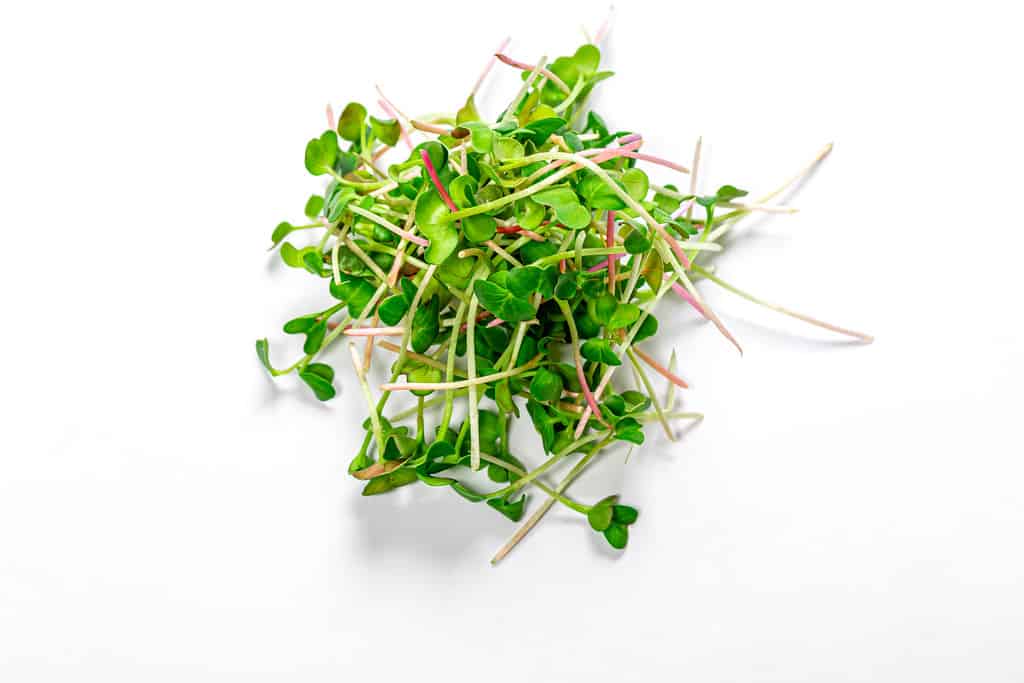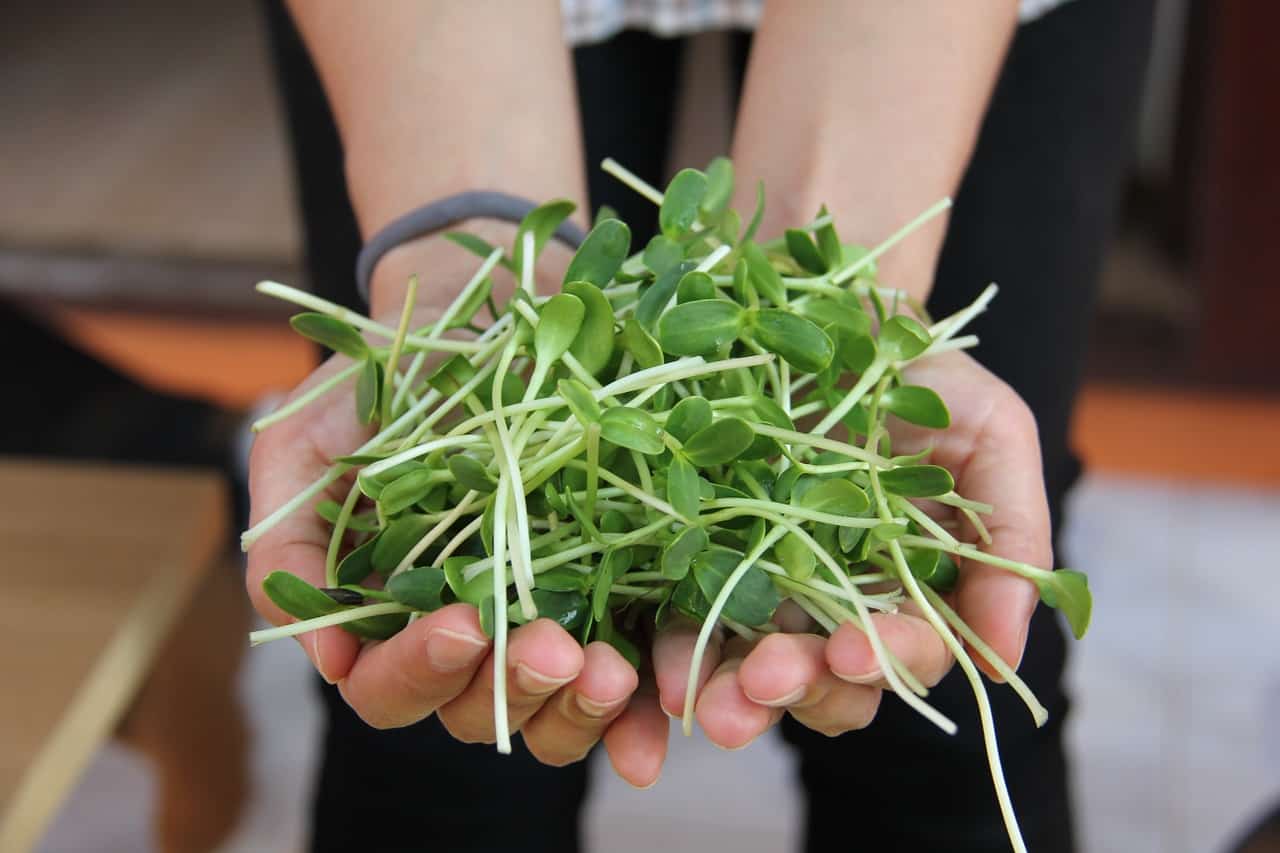If you want to start growing your own food, I highly recommend growing microgreens. Microgreens are green vegetables harvested after the cotyledon leaves have developed. They are extremely nutritious, growing microgreens do not require much space, and many types of microgreens are ready to harvest within a couple of weeks!
Microgreens tend to be rather expensive at the grocery store which may lead one to believe that growing them is capital intensive. However, this is not the case. To start growing microgreens, you only need seeds, a growing medium, a container, and a light source.
There are many species of plants that can be grown as microgreens. However, some species are more beginner-friendly than others. While it may be tempting to start growing some of the more “exotic” microgreens initially, you will enjoy microgreen growing much more if you are able to successfully harvest a crop. Some of the most beginner-friendly microgreens are listed below.
Radish Microgreens

Radish microgreens are great for first-time microgreen growers because they are very forgiving of mistakes. In addition, radish seeds are easy to find and have a high germination rate. Many sources indicate that radish seeds need to be soaked in order to germinate, but I have successfully grown radish microgreens without soaking the seeds.
Radish microgreens can be grown in soil or hydroponically (in water). Radish microgreens have a flavor that is a more intense version of the mature plant. I was surprised how spicy radish microgreens are the first time I tried them. They make a great addition to soups, sandwiches, eggs, omelets, and tacos.
Radish microgreens are ready to harvest 8 to 12 days after sowing seeds. They need 4 to 6 hours of natural sunlight or 8 to 12 hours of full-spectrum artificial lighting to survive. If you grow radish microgreens hydroponically, check the water levels daily to ensure that the growing mat is saturated. Once the seeds germinate, it is important to water your microgreens from the bottom.
For detailed instructions on how to grow radish microgreens, check out this article I wrote the outlines the steps to grow radish microgreens.
Sunflower Microgreens

Sunflower microgreens are the most popular type of microgreens. Not only are they easy to grow, but sunflower microgreens are also delicious. Their nutty flavor makes them a great addition to a wide range of culinary dishes such as soups, salads, and sandwiches. Like radish microgreens, they are very nutritious.
Like other types of microgreens grown from large seeds, sunflower seeds should be soaked prior to sowing the seeds. Although sunflower microgreens are easy to grow, they should be grown in soil rather than hydroponically.
It is important to use food-grade seeds to grow sunflower microgreens. You can use striped sunflower seeds sold as snacks as long as they are not roasted. However, black oil sunflower seeds produce microgreens that are a bit more flavorful. Although sunflower seeds sold as birdseed will germinate, these seeds contain chemicals that are not safe for human consumption.
Sunflower microgreens are ready to harvest 7-10 days after sowing the seeds.
Pea Shoots

Pea shoots, which are also known as pea microgreens, are another great type of microgreen for beginners. These microgreens have a light, refreshing pea flavor. Pea shoots are delicious in salads. If you allow pea shoots to grow a bit longer or taller, they are also delicious sauteed in garlic.
Pea seeds are rather large, so they should be soaked for 8-12 hours prior to sowing the seeds. The seeds germinate within 2-3 days and are ready to harvest 8-14 days after sowing seeds. Pea microgreens have prominent root systems, so it is better for them to be grown in soil rather than hydroponically. However, I have successfully grown pea shoots in hydroponic systems.
Like other microgreens on this last, pea shoots are very nutritious. They contain folate, antioxidants, and carotene which prevent cancer.
Cabbage Microgreens

Cabbage microgreens have a strong broccoli flavor and have a crunchy texture. They are commonly added to sandwiches and salads. These microgreens offer a variety of health benefits and contain nutrients that lower the risk of cardiovascular disease.
You do not have to soak cabbage seeds in order to successfully grow cabbage microgreens. Cabbage microgreens can be grown in soil or hydroponically, but they tend to grow a little better in a hydroponic environment. The seeds will germinate within 2-3 days, and the microgreens are ready to harvest 6-14 days after sowing seeds.
Red cabbage and green cabbage are grown in similar ways. However, research has shown that red cabbage has a higher fiber content than green cabbage. In addition, research has shown that anthocyanins, which are the red pigments in red cabbage, prevent cancer and improve hearth health.
Broccoli Microgreens

Broccoli microgreens are easy to grow and require little care. They have a strong broccoli flavor and are very popular for juicing. They are also good in soups, salads, and chicken sandwiches.
Broccoli microgreens can be grown in soil or hydroponically. The seeds will germinate within 2-3 days, and broccoli microgreens are ready to harvest within 8-12 days of sowing the seeds.
Like other types of microgreens, broccoli microgreens are very nutritious. Broccoli microgreens contain high levels of vitamin C – more than twice the amount of vitamin C in lemons.
Corn Shoots
This is a bonus addition to this list. I added corn shoots because they can be grown from popcorn kernels purchased at the grocery store. In addition, and they only take one week to mature and are surprisingly sweet if grown correctly.

Admittedly, the flavor of corn shoots does not work well with a wide range of culinary dishes. Most people recommend adding them to smoothies or salads. Once they are ready to eat, corn shoots should be eaten as soon as possible because they become bitter quickly. For these reason, I would not grow large quantities of corn shoots because it will probably go to waste.
Unlike the other types of microgreens on this list, corn shoots spend the entirety of their growing cycle in the dark. If you allow corn shoots to be exposed to light, they will become more bitter as they photosynthesize.
To learn more about growing corn shoots, check out this article that I wrote. It outlines each step of growing corn shoots.
Microgreens beginners should avoid…for now
Some types of microgreens are more difficult to grow because the seeds do not germinate very easily and it takes more time to harvest after sowing seeds. In addition, some of these microgreens can be sensitive to temperature or light.
Unfortunately, some of these microgreens are most appealing to grow. However, seeds can be expensive, so it can be very frustrating to unsuccessfully grow these plants when you are first starting out. It is best to grow these more difficult microgreens once you have gained some experience.
Some of the most difficult-to-grow microgreens include:
- Cilantro
- Basil
- Amaranth
- Chives
- Chard

